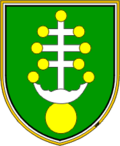Šentilj
|
Šentilj Sankt Egidi, Sankt Ilgen |
|||
|
|||
| Basic data | |||
|---|---|---|---|
| Country |
|
||
| Historic region | Lower Styria / Štajerska | ||
| Statistical region | Podravska (Drau region) | ||
| Coordinates | 46 ° 41 ′ N , 15 ° 39 ′ E | ||
| surface | 65 km² | ||
| Residents | 8,521 (January 1, 2018) | ||
| Population density | 131 inhabitants per km² | ||
| Telephone code | (+386) 2 | ||
| Post Code | 2212 | ||
| License Plate | MB | ||
| Structure and administration | |||
| Mayor : | Štefan Žvab | ||
| Mailing address | Maistrova ulica 2 2212 Šentilj |
||
| Website | |||
Šentilj ( German : Sankt Egidi ; more rarely: Sankt Ilgen ) is a town and municipality in northeastern Slovenia , right on the border with Austria . It is located in the historical Spodnja Štajerska ( Lower Styria ) region and in the statistical region of Podravska .
geography
location
Šentilj is located on the northern edge of the Slovenske gorice ( Windische Bühel ) at about 300 m. ü. A. A large part of the northern border of the municipality is formed by the Mur and thus the border with Austria . In addition to the Mur, the Cirknica ( Zirknitzbach ), Velka ( Wöllingbach ) and Ščavnica ( Stainz ) are important bodies of water in the region, they all flow in a southerly direction to the Drava . The main town is located in the west of the municipality.
The next larger cities are Maribor about 14 km south and Graz in Austria about 46 km north.
Community structure
The municipality comprises 22 localities. The German exonyms in brackets date from the middle of the 19th century and are no longer used officially. (Population figures as of January 1, 2018):
|
|
Neighboring communities
| Straß in Steiermark ( A ) | Mureck ( A ) | Apače |

|
Sveta Ana | |
| Kungota | Pesnica | Sveti Jurij |
economy
In Šentilj there is the largest border crossing between Austria and Slovenia (border crossing Spielfeld / Šentilj), which today forms an EU and Schengen internal border. In addition to the branches of the economy in the service sector that have arisen from transit traffic (e.g. gastronomy), viticulture and fruit growing are traditionally of great importance.
The largest company and employer in the municipality is the Paloma paper mill, founded in 1871 in the Sladki vrh district.
Administration and politics
Šentilj is located in Lower Styria ( Spodnja Štajerska in Slovenian ), part of the historical region of Styria ( Štajerska ). Today it belongs to the statistical region Podravska (Drau region). Mayor is Štefan Žvab. The zip code is 2212.
history
In ancient times, the Roman road from Poetovio (now Ptuj ) to Flavia Solva (near Leibnitz ) led through Šentilj . Ancient graves have been found near Sladki vrh. A fortified settlement from prehistoric times with a total of eleven buildings from different epochs ( Bronze Age , Celts , Romans) was discovered in Ceršak .
As the first district Trate was first mentioned in 1151, the place Šentilj appeared in a document in 1329.
In Štrihovec ( Strichowetz ), Protestant immigrants from Württemberg were settled according to plan at the beginning of the 20th century , but they were expelled from what was then Yugoslavia after the Second World War in 1945 .
Attractions
In Šentilj, the originally medieval parish church of St. Egidi , rebuilt in 1806 in classicist style, is particularly worth seeing.
In the municipality of Šentilj there are also two castles, of which the lower Mureck Castle (in Slovene Cmurek ) was mentioned in a document as early as 1151. Later it came into the possession of the Counts of Cilli . Today, after numerous renovations of the originally Romanesque building in the second half of the 16th and 18th centuries, Mureck Castle is home to a psychiatric institution, which is why the interior rooms and the arcade courtyard from the Renaissance cannot be visited. The Gothic portal is well worth seeing, and the former drawbridge offers an excellent view of the Austrian border town of Mureck .
The higher situated Kapral Castle (Slovenian Kapralov grad ) is much younger and was only built in the 19th century. The former owner Harry Hanson laid out a botanical garden here in 1903 with tulips and numerous other types of flowers.
In Stara Gora ( Altenberg ) a baroque church is worth seeing, in Zgornja Velka ( Oberwölling ) the church Maria Schnee ( Marija Snežna ) from the 18th century.
Daughters and sons of the church
From Šentilj come among others:
- Jakob Lorber (born in the village of Kaniža / Kanischa, 1800–1864), writer and musician
- Mira Sardoc (1930–2008), well-known Slovenian theater and film actress
- Tone Kuntner (* 1943), Slovenian poet and actor
Web links
Individual evidence
- ^ General state law and government gazette for the Crown Land of Styria. 1850 (supplement Marburg district)
- ↑ SI STAT
- ↑ Statistical Office of the Republic of Slovenia ( English )


